Effects of Slope Ecological Restoration on Runoff and Its Response to Climate Change
Abstract
1. Introduction
2. Materials and Methods
2.1. Study Area
2.2. Data and Process
2.2.1. Data Sources
2.2.2. Data Processing
2.3. Key Technologies and Identification Methods
2.3.1. Distributed Hydrological Model
Model Structure and Simulation Elements
Model Calibration and Validation Criteria
2.3.2. Extent of Slope Ecological Restoration
2.3.3. Impacts on the Historical Runoff Process
2.3.4. Mitigation of Future Climate Change
3. Results
3.1. Spatial Analysis of Slope Ecological Restoration in Different Periods
3.2. Model Calibration and Validation
3.3. Impacts of the Different Periods of the Slope Ecological Restoration on the Runoff Process of the River Channel
3.4. Mitigation of Slope Ecological Restoration on Climate Change
4. Discussion
4.1. Analysis of the Impacts of Slope Ecological Restoration on Runoff
4.2. Analysis of the Spatial Impact of Slope Ecological Restoration on Runoff Variability
4.3. Analysis of the Mitigation of Slope Ecological Restoration on Future Climate Change
5. Conclusions
Author Contributions
Funding
Acknowledgments
Conflicts of Interest
References
- Zhang, C.; Shoemaker, C.A.; Woodbury, J.D.; Cao, M.; Zhu, X. Impact of human activities on stream flow in the Biliu River Basin, China. Hydrol. Process. 2013, 27, 2509–2523. [Google Scholar] [CrossRef]
- He, Y.; Song, J.; Hu, Y.; Tu, X.; Zhao, Y. Impacts of different weather conditions and landuse change on runoff variations in the Beiluo River Watershed, China. Sustain. Cities Soc. 2019, 50, 101674. [Google Scholar] [CrossRef]
- Sivakumar, B. Global climate change and its impacts on water resources planning and management: Assessment and challenges. Stoch. Eviron. Res. Risk Assess. 2011, 25, 583–600. [Google Scholar] [CrossRef]
- Wu, Z.; Chen, X.; Lu, G.; Xiao, H.; He, H.; Zhang, J. Regional response of runoff in cmip5 multi-model climate projections of Jiangsu Province, China. Stoch. Eviron. Res. Risk Assess. 2016, 31, 2627–2643. [Google Scholar] [CrossRef]
- Jatin, A.; Gosain, A.K.; Khosa, R. Prediction of land use changes based on Land Change Modeler and attribution of changes in the water balance of Ganga basin to land use change using the SWAT model. Sci. Total Environ. 2018, 644, 503–519. [Google Scholar] [CrossRef]
- Nadal-Romero, E.; Cammeraat, E.; Serrano-Muela, M.P.; Lana-Renault, N.; Regüés, D. Hydrological response of an afforested catchment in a mediterranean humid mountain area: A comparative study with a natural forest. Hydrol. Process. 2016, 30, 2717–2733. [Google Scholar] [CrossRef]
- Guoce, X.; Jiaxin, Z.; Peng, L.; Zhanbin, L.; Kexin, L.; Xiukang, W.; Feichao, W.; Yuting, C.; Bin, W. Vegetation restoration projects and their influence on runoff and sediment in china. Ecol. Indic. 2018, 95, 233–241. [Google Scholar] [CrossRef]
- Shrestha, M.K.; Recknagel, F.; Frizenschaf, J.; Meyer, W. Future climate and land uses effects on flowand nutrient loads of a Mediterranean catchment in South Australia. Sci. Total Environ. 2017, 590–591, 186–193. [Google Scholar] [CrossRef]
- Coles, A.E.; Mcconkey, B.G.; Mcdonnell, J.J. Climate change impacts on hillslope runoff on the northern great plains, 1962–2013. J. Hydrol. 2017, 550, 538–548. [Google Scholar] [CrossRef]
- Wang, X.B.; He, K.N.; Dong, Z. Effects of climate change and human activities on runoff in the Beichuan River Basin in the northeastern Tibetan Plateau, China. CATENA 2019, 176, 81–93. [Google Scholar] [CrossRef]
- Niloofar, F.; Najmeh, M. Evaluating the contribution of the climate change and human activities to runoff change under uncertainty. J. Hydrol. 2019, 574, 872–891. [Google Scholar] [CrossRef]
- Yan, X.L.; Bao, Z.X.; Zhang, J.Y.; Wang, G.Q.; He, R.M.; Liu, C.S. Quantifying contributions of climate change and local human activities to runoff decline in the upper reaches of the Luanhe River basin. J. Hydro Environ. Res. 2019, in press. [Google Scholar] [CrossRef]
- Yu, M.; Wang, G.; Pal, J.S. Effects of vegetation feedback on future climate change over west africa. Clim. Dyn. 2015, 46, 1–20. [Google Scholar] [CrossRef]
- Su, F.; Zhang, L.; Ou, T.; Chen, D.; Yao, T.; Tong, K.; Qi, Y. Hydrological response to future climate changes for the major upstream river basins in the tibetan plateau. Glob. Plan. Chang. 2015, 136, 82–95. [Google Scholar] [CrossRef]
- Eum, H.I.; Dibike, Y.; Prowse, T. Climate-induced alteration of hydrologic indicators in the athabasca river basin, Alberta, Canada. J. Hydrol. 2016, 544, 327–342. [Google Scholar] [CrossRef]
- Eisner, S.; Flörke, M.; Chamorro, A.; Daggupati, P.; Donnelly, C.; Huang, J.; Hundecha, Y.; Koch, H.; Kalugin, A.; Krylenko, I.; et al. An ensemble analysis of climate change impacts on streamflow seasonality across 11 large river basins. Clim. Chang. 2017, 141, 401–417. [Google Scholar] [CrossRef]
- Teklesadik, A.D.; Alemayehu, T.; Griensven, A.V.; Kumar, R.; Liersch, S.; Eisner, S.; Tecklenburg, J.; Ewunte, S.; Wang, X. Inter-model comparison of hydrological impacts of climate change on the upper blue nile basin using ensemble of hydrological models and global climate models. Clim. Chang. 2018, 141, 517–532. [Google Scholar] [CrossRef]
- Qin, P.H.; Chen, F.; Xie, Z.H. Effects of crop growth on hydrological processes over river basins and regional climate. Adv. Clim. Chang. Res. 2012, 8, 418–425. [Google Scholar]
- Gao, C.; Liu, L.; Ma, D.; He, K.Q.; Xu, Y.P. Assessing responses of hydrological processes to climate change over the southeastern Tibetan Plateau based on resampling of future climate scenarios. Sci. Total Environ. 2019, 664, 737–752. [Google Scholar] [CrossRef]
- Shengqi, J.; Chuanyan, Z.; Shumin, F.; Kai, Y. Effects of different vegetation restoration on soil water storage and water balance in the chinese loess plateau. Agric. For. Meteorol. 2015, 206, 85–96. [Google Scholar] [CrossRef]
- Hatma, S. Rainfall-runoff investigation of pine forest plantation in the upstream area of Gajah Mungkur reservoir. Procedia Environ. Sci. 2015, 28, 307–314. [Google Scholar] [CrossRef]
- Chu, S.; Ouyang, J.; Liao, D.; Zhou, Y.; Liu, S.; Shen, D.; Wei, X.; Zeng, S. Effects of enriched planting of native tree species on surface water flow, sediment, and nutrient losses in a eucalyptus plantation forest in southern china. Sci. Total Environ. 2019, 675, 224–234. [Google Scholar] [CrossRef] [PubMed]
- Zhang, W.; Hu, G.; Dang, Y.; Weindorf, D.C.; Sheng, J. Afforestation and the impacts on soil and water conservation at decadal and regional scales in northwest china. J. Arid Environ. 2016, 130, 98–104. [Google Scholar] [CrossRef]
- Zhang, F.; Xing, Z.; Zhao, C.; Deng, J.; Yang, B.; Tian, Q.; Herb, W.R.; Nasem, B. Characterizing long-term soil and water erosion and their interactions with various conservation practices in the semi-arid Zulihe Basin, Dingxi, Gansu, China. Ecol. Eng. 2017, 106, 458–470. [Google Scholar] [CrossRef]
- Pengtao, Y.; Yanhui, W.; Neil, C.; Wei, X.; Lihong, X. Simulation of runoff changes caused by cropland to forest conversion in the upper Yangtze River Region, Sw China. PLoS ONE 2015, 10, e0132395. [Google Scholar] [CrossRef]
- Yang, W.T.; Long, D.; Bai, P. Impacts of future land cover and climate changes on runoff in the mostly afforested river basin in North China. J. Hydrol. 2019, 570, 201–219. [Google Scholar] [CrossRef]
- Wei, X.H.; Zhang, M.F. Quantifying streamflow change caused by forest disturbance at a large spatial scale: A single watershed study. Water Resour. Res. 2010, 46, 439–445. [Google Scholar] [CrossRef]
- Zhang, X.; Zhang, L.; Zhao, J.; Rustomji, P.; Hairsine, P. Responses of streamflow to changes in climate and land use/cover in the Loess Plateau, China. Water Resour. Res. 2008, 44, W00A07. [Google Scholar] [CrossRef]
- Zhang, M.; Wei, X. The effects of cumulative forest disturbance on streamflow in a large watershed in the central interior of British Columbia, Canada. Hydrol. Earth Syst. Sci. 2012, 16, 2021–2034. [Google Scholar] [CrossRef]
- Andersson, L.; Wilk, J.; Todd, M.C.; Hughes, D.A.; Earle, A.; Kniveton, D.; Layberry, R.; Savenije, H.H.G. Impact of climate change and development scenarios on flow patterns in the Okavango River. J. Hydrol. 2006, 331, 43–57. [Google Scholar] [CrossRef]
- Li, Z.; Liu, W.Z.; Zhang, X.C.; Zheng, F.L. Impacts of land use change and climate variability on hydrology in an agricultural catchment on the Loess Plateau of China. J. Hydrol. 2009, 377, 35–42. [Google Scholar] [CrossRef]
- Zhang, Q.; Xu, C.Y.; Yang, T. Variability of water resource in the yellow river basin of past 50 years, China. Water Resour. Manag. 2009, 23, 1157–1170. [Google Scholar] [CrossRef]
- Yang, Z.; Liu, Q. Response of streamflow to climate changes in the Yellow River Basin, China. J. Hydrometeorol. 2011, 12, 1113–1126. [Google Scholar] [CrossRef]
- Hongxing, Z.; Lu, Z.; Ruirui, Z.; Changming, L.; Yoshinobu, S.; Yoshihiro, F. Responses of streamflow to climate and land surface change in the headwaters of the yellow river basin. Water Resour. Res. 2009, 45, 641–648. [Google Scholar] [CrossRef]
- Oudin, L.; Andréassian, V.; Lerat, J.; Michel, C. Has land cover a significant impact on mean annual streamflow? An international assessment using 1508 catchments. J. Hydrol. 2008, 357, 303–316. [Google Scholar] [CrossRef]
- Yang, D.; Shao, W.; Yeh, P.J.F.; Yang, H.; Kanae, S.; Oki, T. Impact of vegetation coverage on regional water balance in the nonhumid regions of China. Water Resour. Res. 2009, 45, W00A14. [Google Scholar] [CrossRef]
- Zhang, L.; Podlasly, C.; Feger, K.H.; Wang, Y.; Schwarzel, K. Different land management measures and climate change impacts on the runoff—A simple empirical method derived in a mesoscale catchment on the loess plateau. J. Arid Environ. 2015, 120, 42–50. [Google Scholar] [CrossRef]
- Gao, Y.; Li, X.; Leung, L.R.; Chen, D.; Xu, J. Aridity changes in the Tibetan Plateau in a warming climate. Environ. Res. Lett. 2015, 10, 34013–34024. [Google Scholar] [CrossRef]
- Piao, S.; Ciais, P.; Huang, Y.; Shen, Z.; Peng, S.; Li, J.; Zhou, L.; Liu, H.; Ma, Y.; Ding, Y.; et al. The impacts of climate change on water resources and agriculture in China. Nature 2010, 467, 43–51. [Google Scholar] [CrossRef]
- Li, X.P.; Liu, X.Y.; Li, Y. Study on erosion and deposition trend in the future in the lower Yellow River. Yellow River 2016, 38, 1–3. [Google Scholar]
- Lin, T.; Xu, P.; Qian, H.; Hou, K.; Yang, M. Assessment of water quality and analysis of pollution source in Ningxia section of the Yellow River. Environ. Chem. 2017, 36, 1388–1396. [Google Scholar]
- Hu, Y.; Maskey, S.; Uhlenbrook, S. Streamflow trends and climate linkages in the source region of the Yellow River, China. Hydrol. Process. 2011, 25, 3399–3411. [Google Scholar] [CrossRef]
- Cheng, P. Water Quality Assessment Study Based on TOPSIS Method: Take Lanzhou Section of Yellow River as an Example. Master’s Thesis, Lanzhou University, Lanzhou, China, 2014. [Google Scholar]
- Field, C.B.; Barros, V.; Stocker, T.F.; Qin, D.; Dokken, D.J.; Ebi, K.L.; Mastrandrea, K.J.; Mach, G.-K.; Plattner, S.K.; Allen, S.K.; et al. IPCC, 2012: Managing the Risks of Extreme Events and Disasters to Advance Climate Change Adaptation. A Special Report of Working Groups I and II of the Intergovernmental Panel on Climate Change; Cambridge University Press: Cambridge, UK, 2013. [Google Scholar]
- Xu, C.H.; Xu, Y. The projection of temperature and precipitation over China under RCP Scenarios using a cmip5 multi-model ensemble. Atmos. Ocean. Sci. Lett. 2012, 5, 527–533. [Google Scholar] [CrossRef]
- Wang, L.; Chen, W.; Wen, A. Application of bias correction and spatial disaggregation in removing model biases and downscaling over China. Adv. Earth Sci. 2013, 28, 1144–1153. [Google Scholar]
- Zhao, F.; Xu, Z. Hydrological response to climate change in headwater catchment of the Yellow River Basin. Resour. Sci. 2009, 31, 722–730. [Google Scholar]
- Weedon, G.P.; Gomes, S.; Viterbo, P.; Shuttleworth, W.J.; Blyth, E.; Osterle, H.; Adam, J.C.; Bellouin, N.; Boucher, O.; Best, M. Creation of the watch forcing data and its use to assess global and regional reference crop evaporation over land during the twentieth century. J. Hydrometeorol. 2011, 12, 823–848. [Google Scholar] [CrossRef]
- Liu, C.; Dong, Z.; Fang, Q.; Shan, C. Runoff change in response to climate change and human activities scenarios of luanhe river basin. Water Resour. Power 2013, 31, 12–15. [Google Scholar]
- Piani, C.; Weedon, G.P.; Best, M.; Gomes, S.M.; Viterbo, P.; Hagemann, S.; Haerter, J.O. Statistical bias correction of global simulated daily precipitation and temperature for the application of hydrological models. J. Hydrol. 2010, 395, 199–215. [Google Scholar] [CrossRef]
- Hagemann, S.; Chen, C.; Haerter, J.O.; Heinke, J.; Gerten, D.; Piani, C. Impact of a statistical bias correction on the projected hydrological changes obtained from three GCMs and two hydrology models. J. Hydrometeorol. 2011, 12, 556–578. [Google Scholar] [CrossRef]
- Warszawski, L.; Frieler, K.; Huber, V.; Piontek, F.L.; Serdeczny, O.; Schewe, J. The inter-sectoral impact model intercomparison project (ISI–MIP): Project framework. Proc. Natl. Acad. Sci. USA 2014, 111, 3228–3232. [Google Scholar] [CrossRef]
- Hempel, S.; Frieler, K.; Warszawski, L.; Schewe, J.; Piontek, F. A trend-preserving bias correction—The ISI-MIP approach. Earth Syst. Dyn. 2013, 4, 219–236. [Google Scholar] [CrossRef]
- Leng, G.; Tang, Q.; Rayburg, S. Climate change impacts on meteorological, agricultural and hydrological droughts in China. Glob. Plan. Chang. 2015, 126, 23–34. [Google Scholar] [CrossRef]
- Zhang, S.; Gu, Y.; Lin, J. Uncertainty analysis in the application of climate models. Adv. Water Sci. 2010, 21, 505–511. [Google Scholar]
- Wang, S.W.; Luo, Y.; Zhao, Z.C.; Wen, X.Y.; Huang, J.B. Climate models. Adv. Clim. Chang. Res. 2013, 9, 150–154. [Google Scholar]
- Jia, Y.; Wang, H.; Zhou, Z.; Qiu, Y.; Luo, X.; Wang, J.; Yan, D.; Qin, D. Development of the WEP-L distributed hydrological model and dynamic assessment of water resources in the yellow river basin. J. Hydrol. 2006, 331, 629. [Google Scholar] [CrossRef]
- Avissar, R.; Pielke, R.A. A parameterization of heterogeneous land-surface for atmospheric numerical models and its impact on regional meteorology. Mon. Weather Rev. 1989, 117, 2113–2136. [Google Scholar] [CrossRef]
- Zhou, Z.; Jia, Y.; Qiu, Y.; Liu, J.; Wang, H.; Xu, C.; Li, J.; Liu, L. Simulation of dualistic hydrological processes affected by intensive human activities based on distributed hydrological model. J. Water Resour. Plann. Manag. 2018, 144, 04018077. [Google Scholar] [CrossRef]
- Li, J.; Zhou, Z.; Wang, H.; Liu, J.; Jia, Y.; Hu, P.; Xu, C. Development of WEP-COR model to simulate land surface water and energy budgets in a cold region. Hydrol. Res. 2019, 50, 606–629. [Google Scholar] [CrossRef]
- Peng, H.; Jia, Y.; Niu, C.; Gong, J.; Gou, S. Eco-hydrological simulation of soil and water conservation in the Jinghe River Basin in the Loess Plateau, China. J. Hydro Environ. Res. 2015, 9, 452–464. [Google Scholar] [CrossRef]
- Zhang, Y.; Luo, Y.; Sun, L.; Liu, S.; Chen, X.; Wang, X. Using glacier area ratio to quantify effects of melt water on runoff. J. Hydrol. 2016, 538, 269–277. [Google Scholar] [CrossRef]
- Wessman, C.A. Spatial scales and global change: Bridging the gap from plots to GCM grid cells. Annu. Rev. Ecol. Syst. 1992, 23, 175–200. [Google Scholar] [CrossRef]
- Hunsaker, C.T.; Levine, D.A. Hierarchical approaches to the study of water quality in rivers. Bioscience 1995, 45, 193–203. [Google Scholar] [CrossRef]
- Kamga, F.M. Impact of greenhouse gas induced climate change on the runoff of the Upper Benue River (Cameroon). J. Hydrol. 2001, 252, 145–156. [Google Scholar] [CrossRef]
- Huang, M.; Zhang, L.; Gallichand, J. Runoff responses to afforestation in a watershed of the loess plateau, china. Hydrol. Process. 2010, 17, 2599–2609. [Google Scholar] [CrossRef]
- Li, S.; Liang, W.; Fu, B.J.; Lv, Y.H.; Fu, S.Y.; Wang, S.; Su, H.M. Vegetation changes in recent large-scale ecological restoration projects and subsequent impact on water resources in china’s loess plateau. Sci. Total Environ. 2016, 569–570, 1032–1039. [Google Scholar] [CrossRef] [PubMed]
- Sun, G.; Zhou, G.; Zhang, Z.; Wei, X.; Mcnulty, S.G.; Vose, J.M. Potential water yield reduction due to forestation across China. J. Hydrol. 2006, 328, 558. [Google Scholar] [CrossRef]
- Feng, X.M.; Sun, G.; Fu, B.J.; Su, C.H.; Liu, Y.; Lamparski, H. Regional effects of vegetation restoration on water yield across the Loess Plateau, China. Hydrol. Earth Syst. Sci. 2012, 16, 2617–2628. [Google Scholar] [CrossRef]
- Li, Q.; Wei, X.; Zhang, M.; Liu, W.; Giles-Hansen, K.; Wang, Y. The cumulative effects of forest disturbance and climate variability on streamflow components in a large forest-dominated watershed. J. Hydrol. 2018, 557, 448–459. [Google Scholar] [CrossRef]
- Winkler, R.D.; Spittlehouse, D.L.; Golding, D.L. Measured differences in snow accumulation and melt among clearcut, juvenile, and mature forests in southern British Columbia. Hydrol. Process. 2005, 19, 51–62. [Google Scholar] [CrossRef]
- Cuo, L.; Zhang, Y.; Gao, Y.; Hao, Z.; Cairang, L. The impacts of climate change and land cover/use transition on the hydrology in the upper Yellow River Basin, China. J. Hydrol. 2013, 502, 37–52. [Google Scholar] [CrossRef]
- Hoang, L.; Schneiderman, E.M.; Moore, K.E.B.; Mukundan, R.; Owens, E.M.; Steenhuis, T.S. Predicting saturation-excess runoff distribution with a lumped hillslope model SWAT-HS. Hydrol. Proces. 2017, 31, 2226–2243. [Google Scholar] [CrossRef]
- Savenije, H.H.G. Topography driven conceptual modelling (FLEX-TOPO). Hydrol. Earth Syst. Sci. 2010, 14, 2681–2692. [Google Scholar] [CrossRef]
- Xie, X.; Liang, S.; Yao, Y.; Jia, K.; Meng, S.; Li, J. Detection and attribution of changes in hydrological cycle over the three-north region of china: Climate change versus afforestation effect. Agric. For. Meteorol. 2015, 203, 74–87. [Google Scholar] [CrossRef]
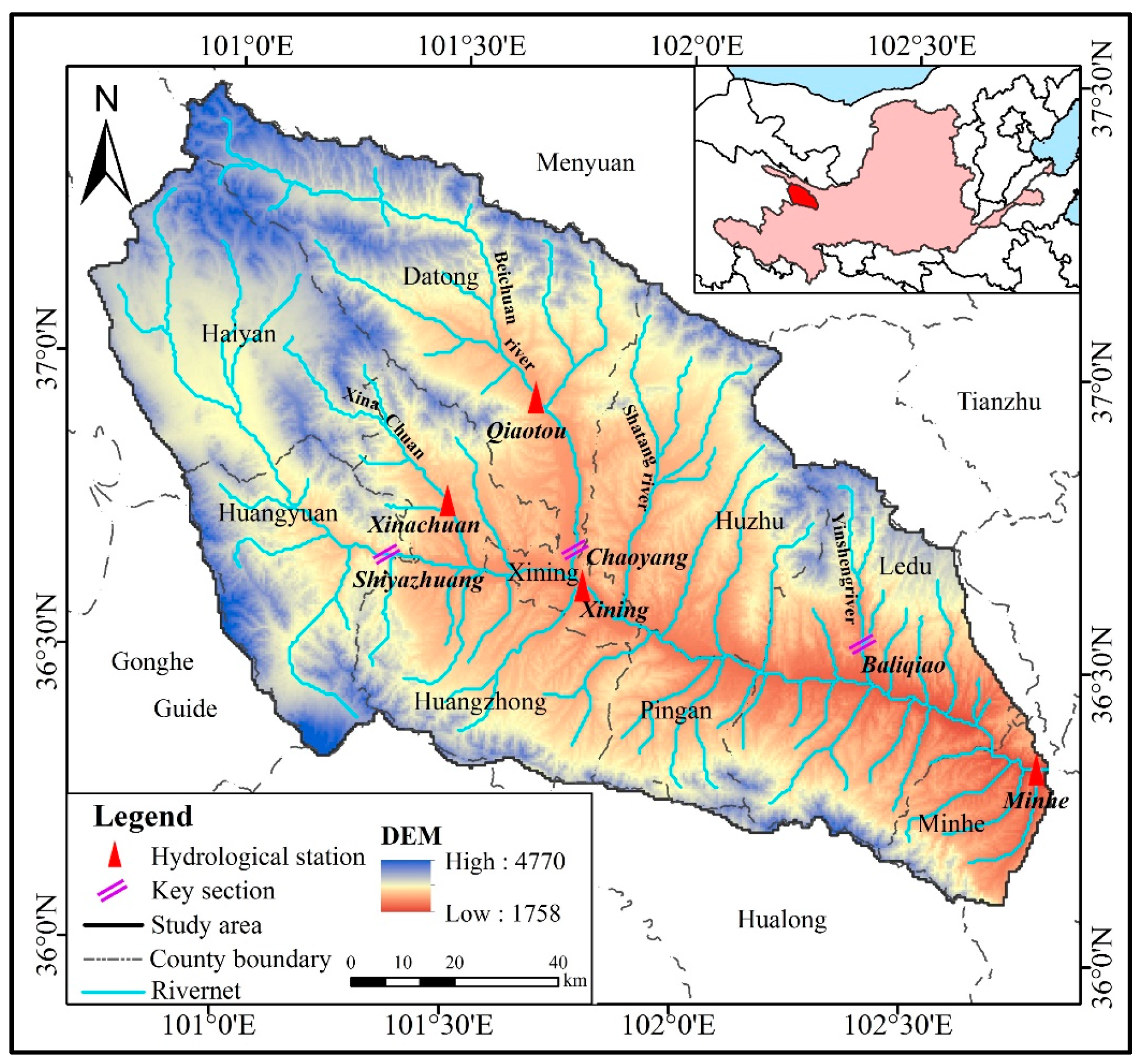
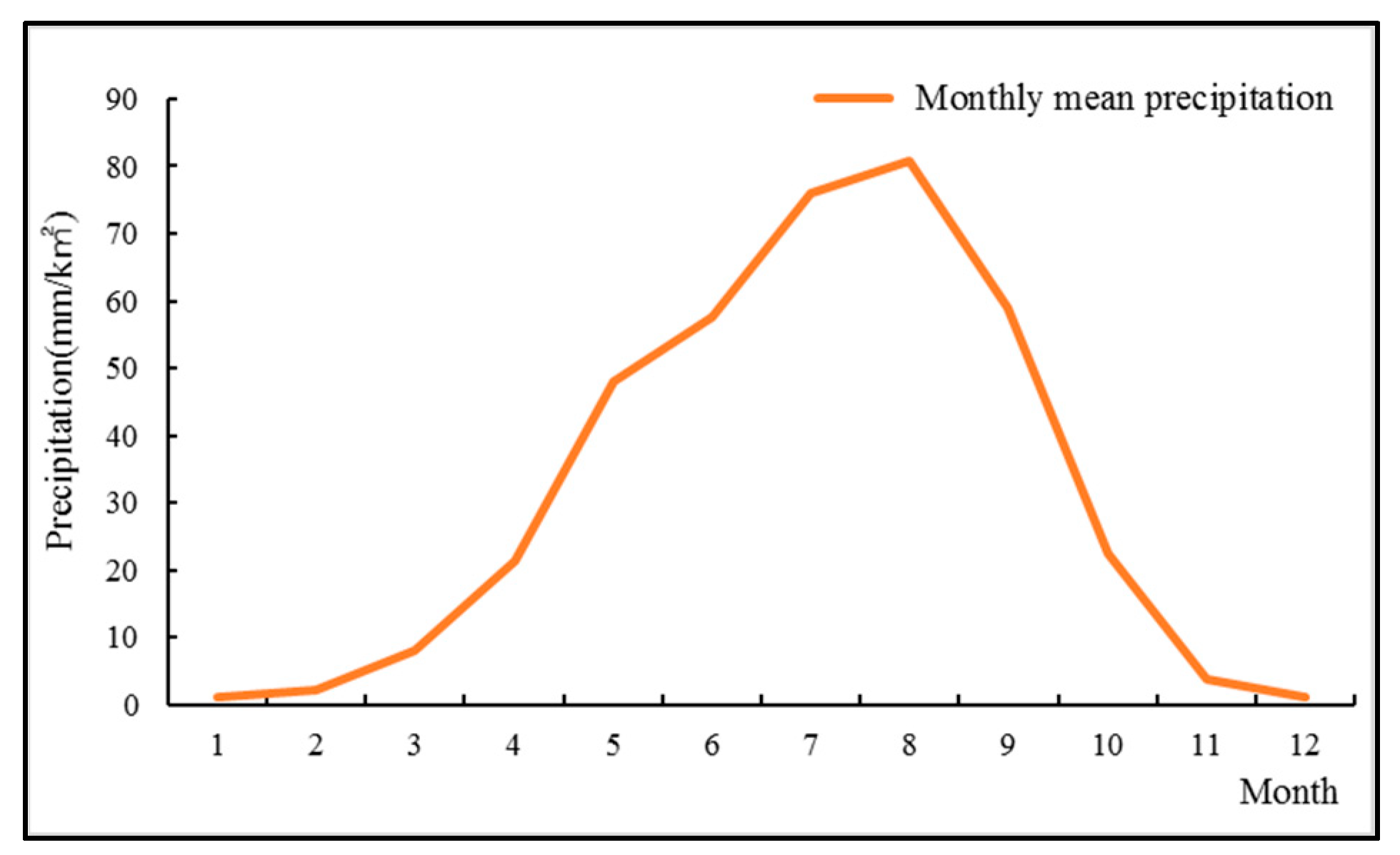
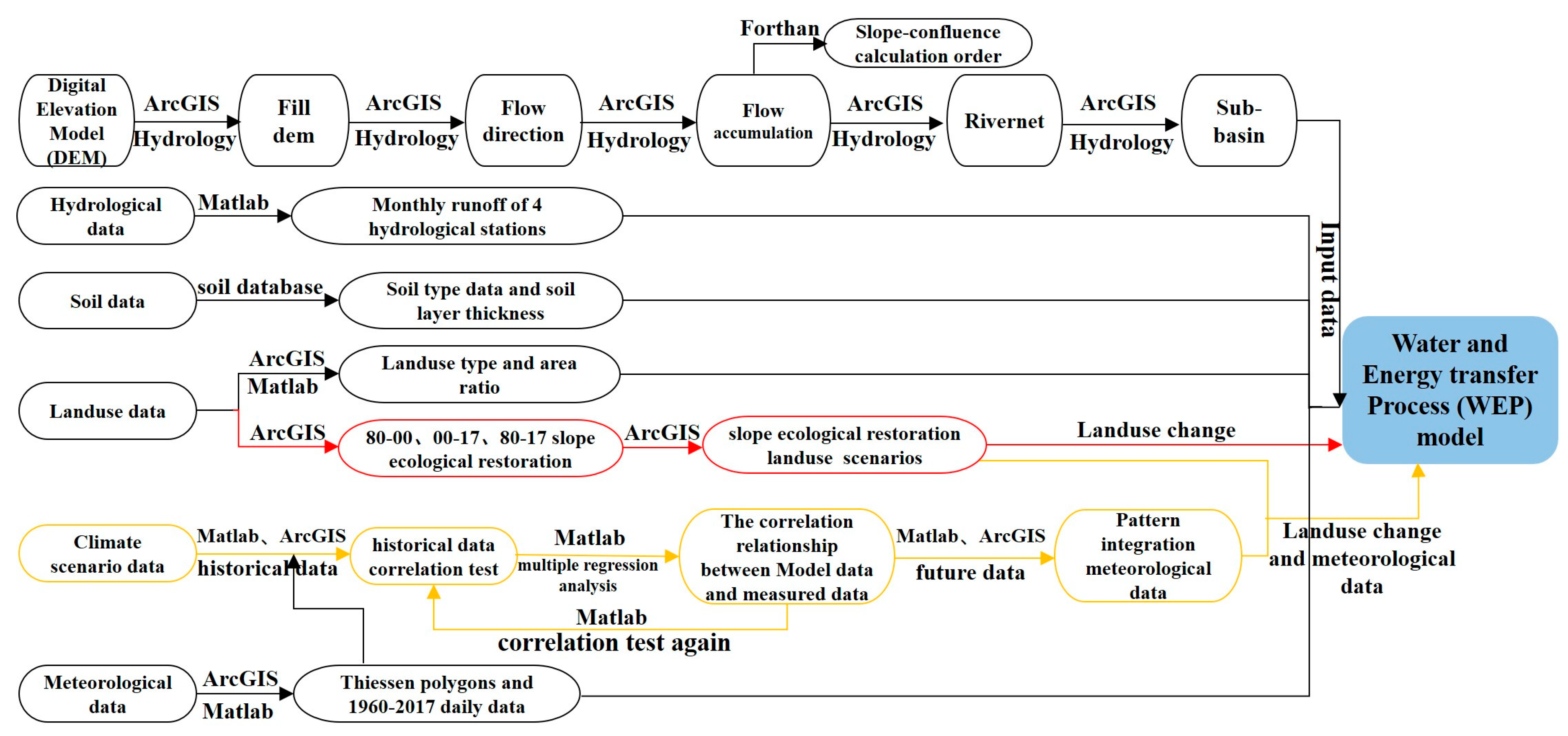
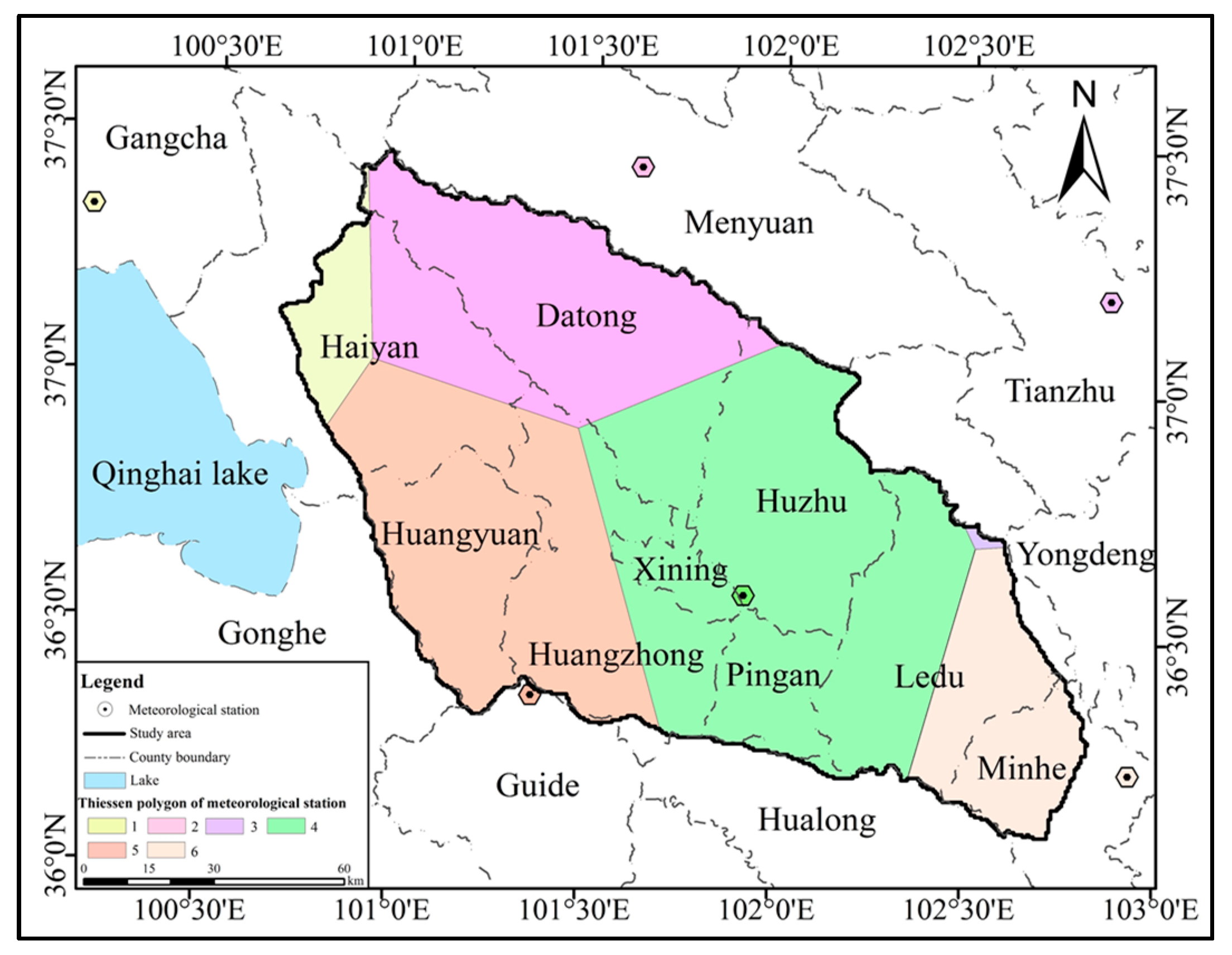
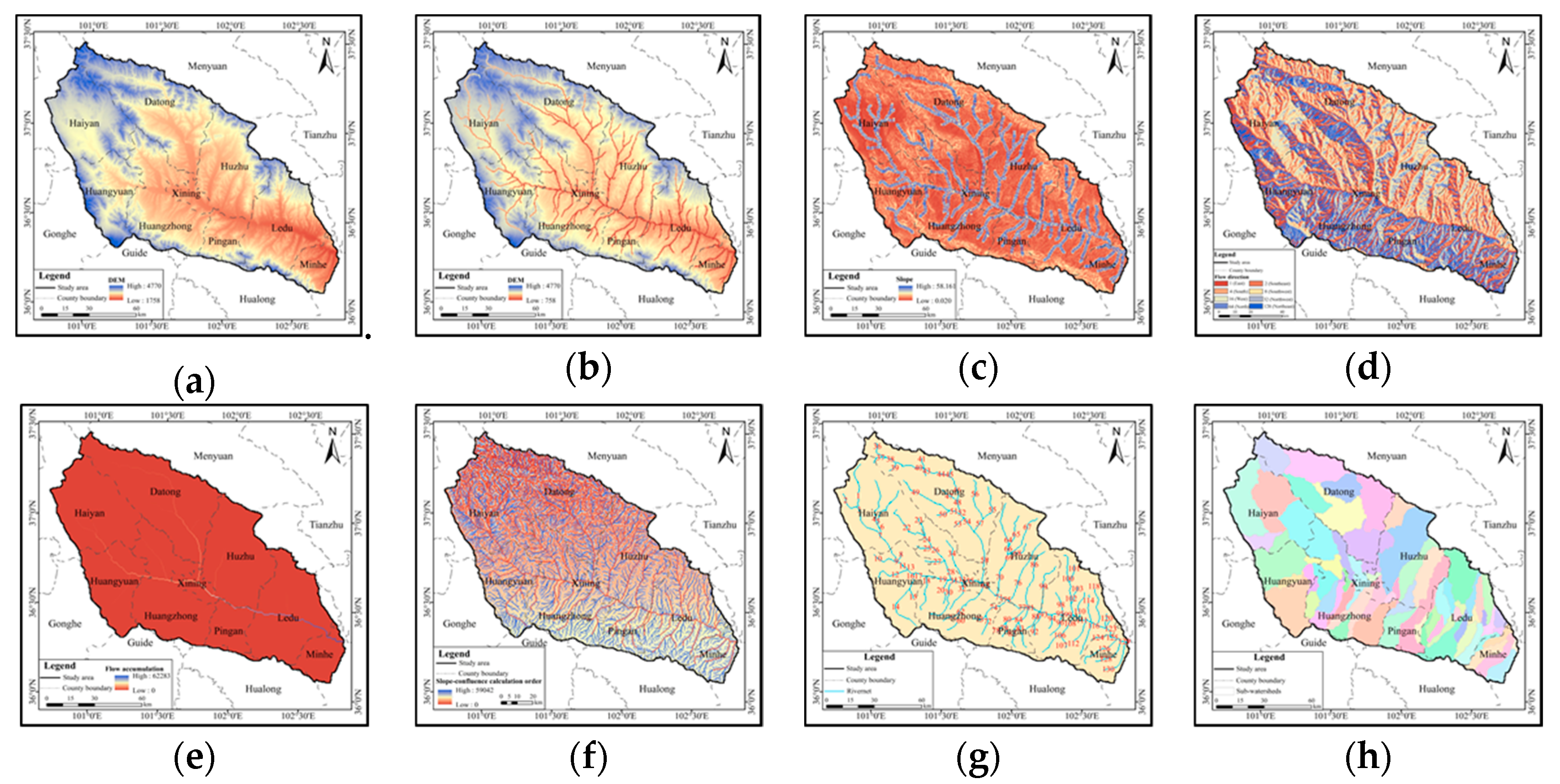
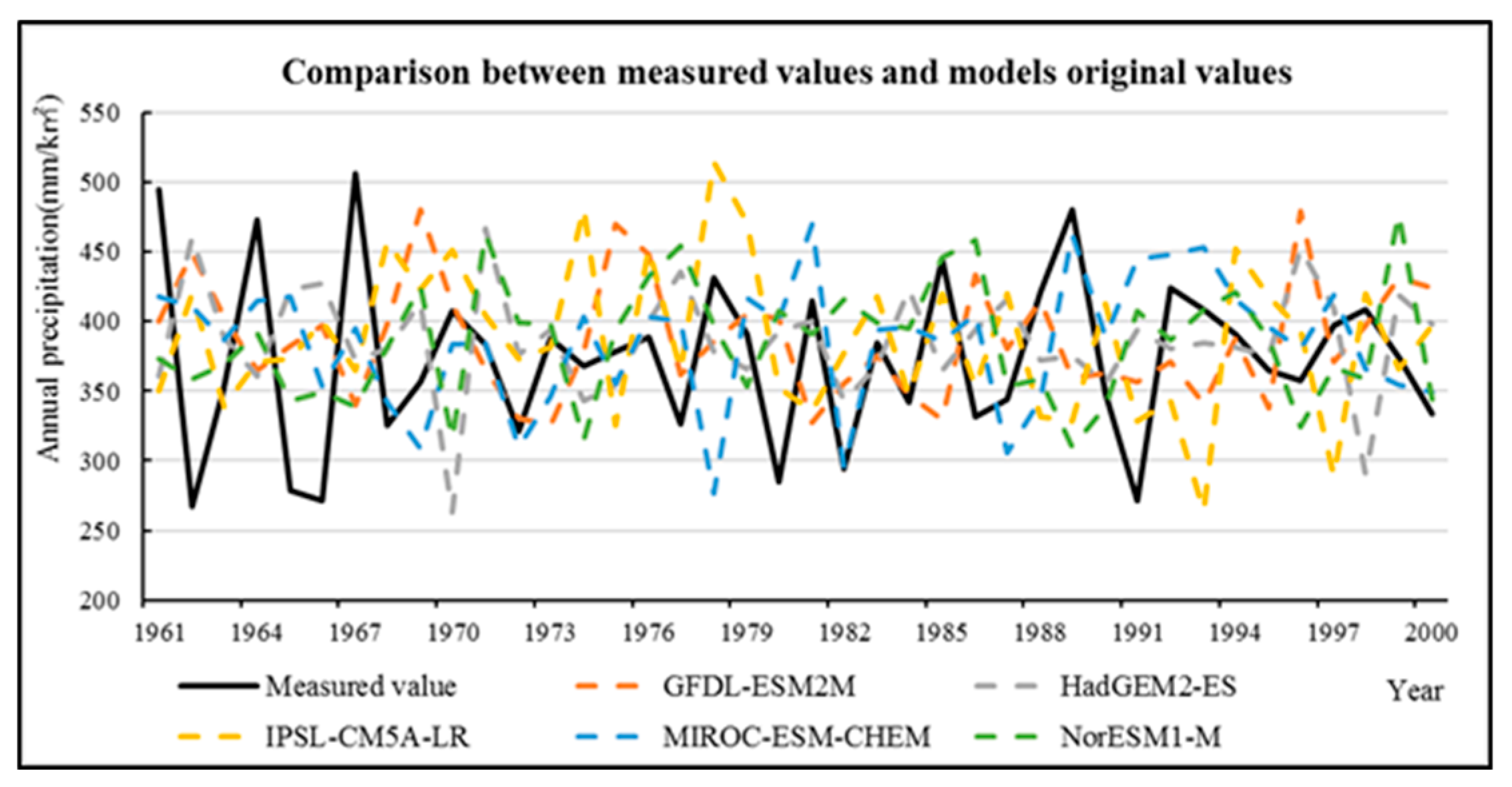



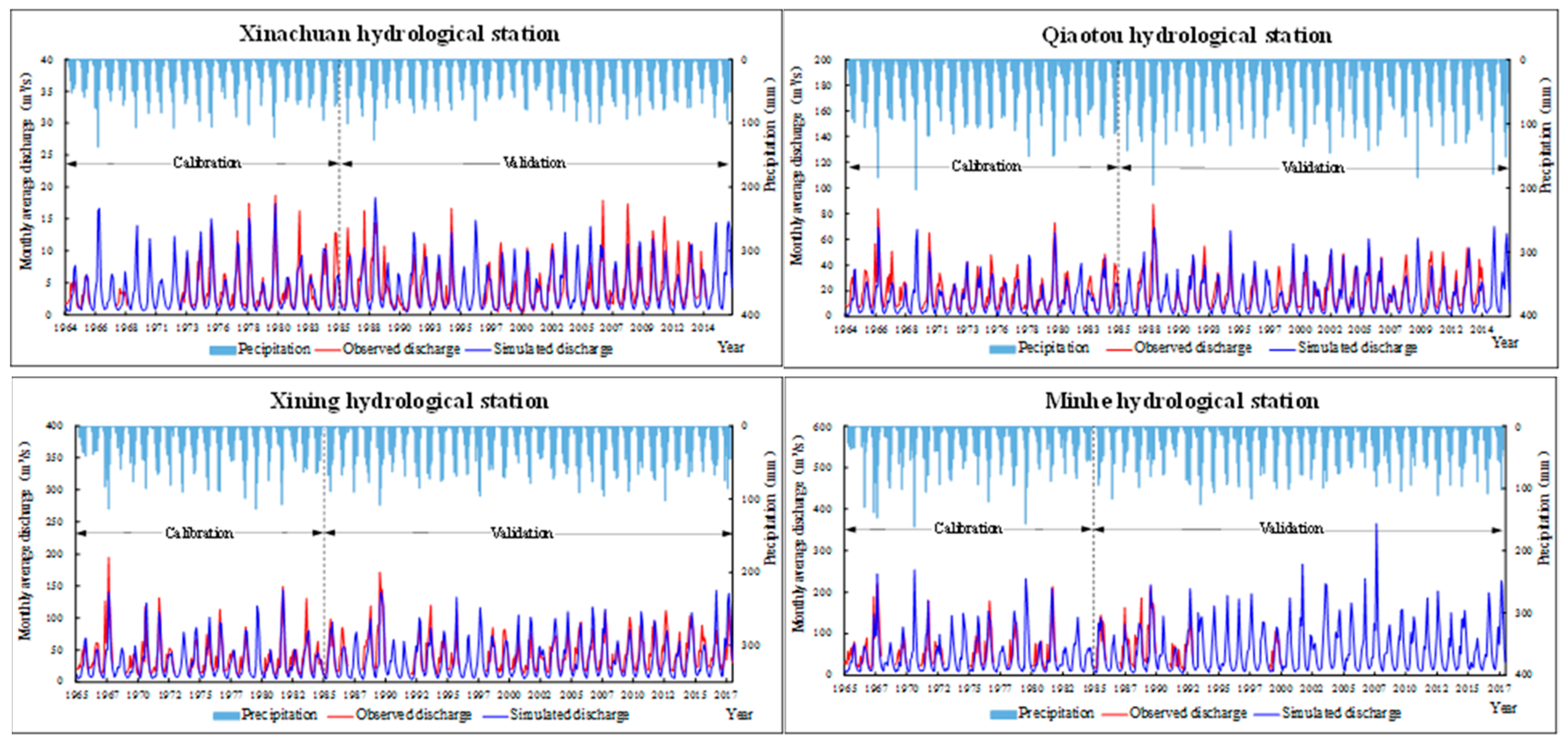
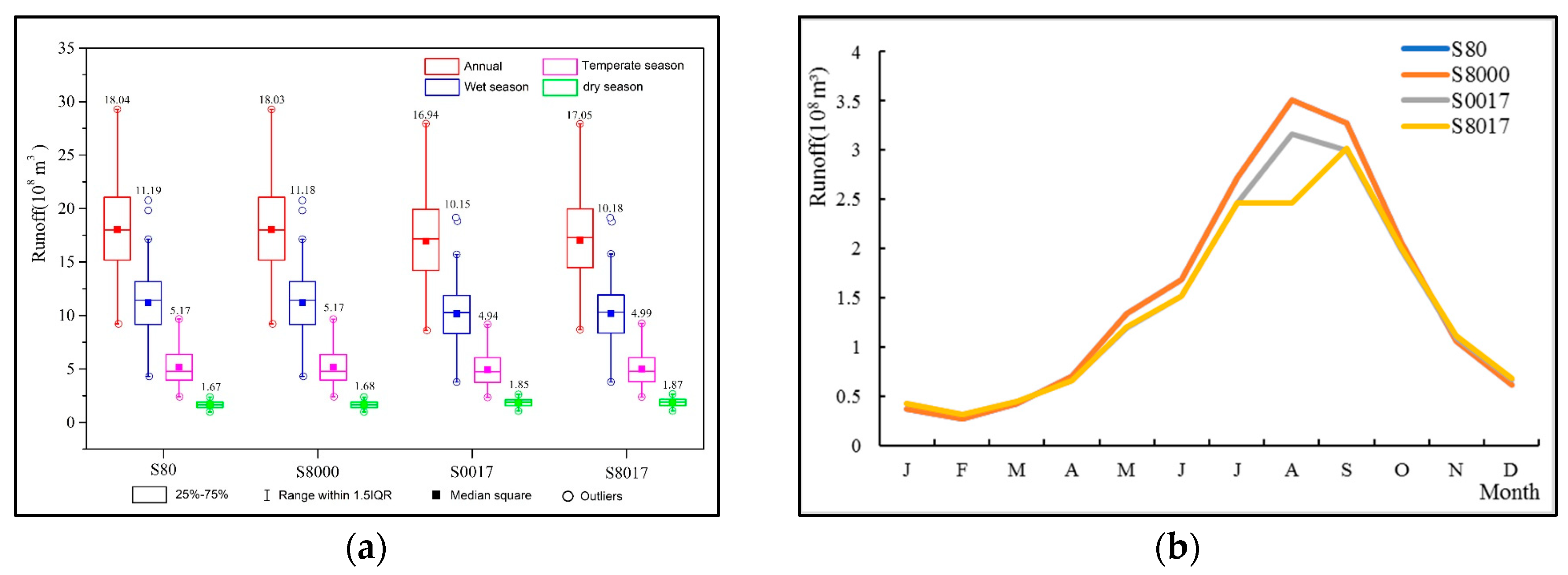
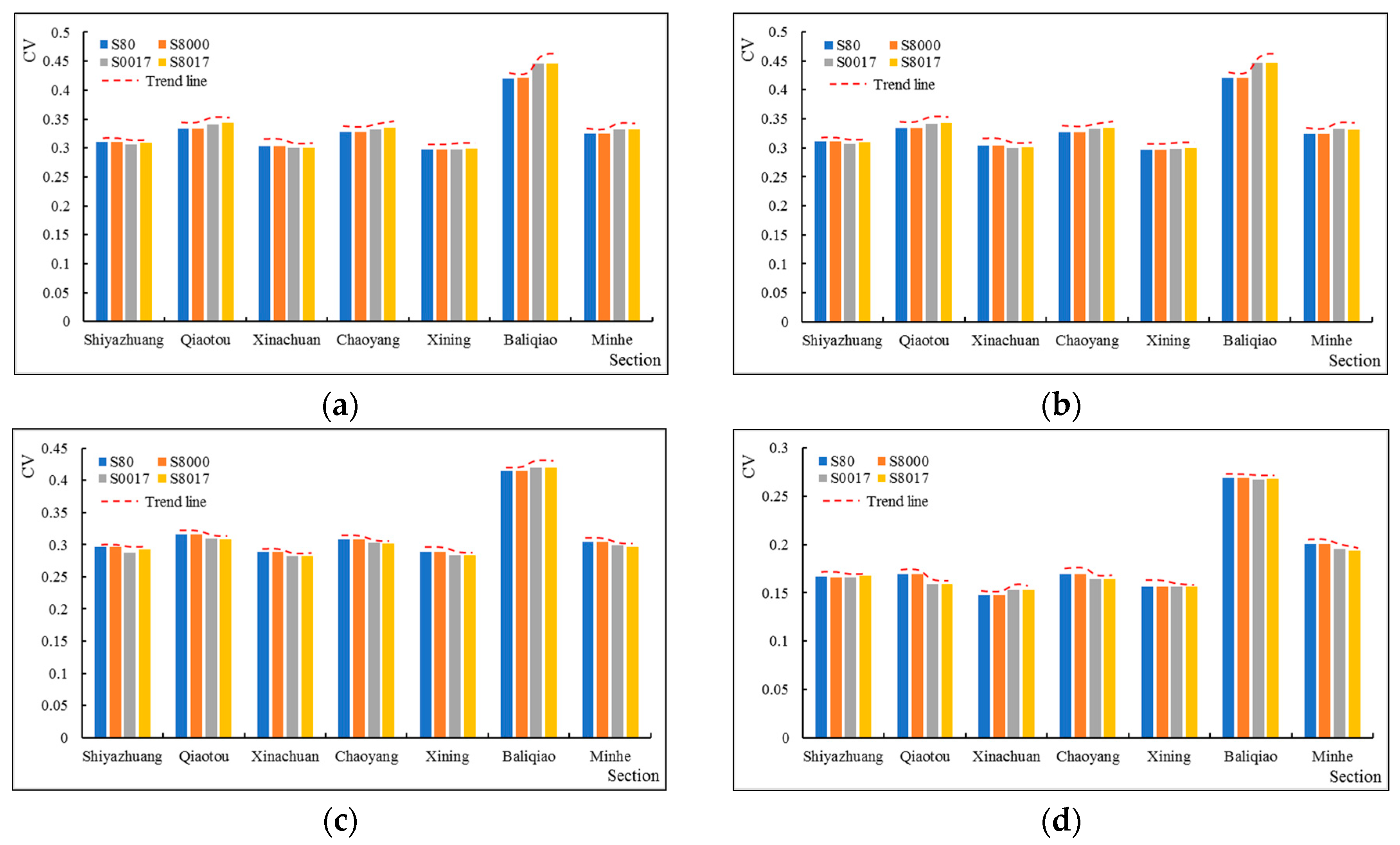

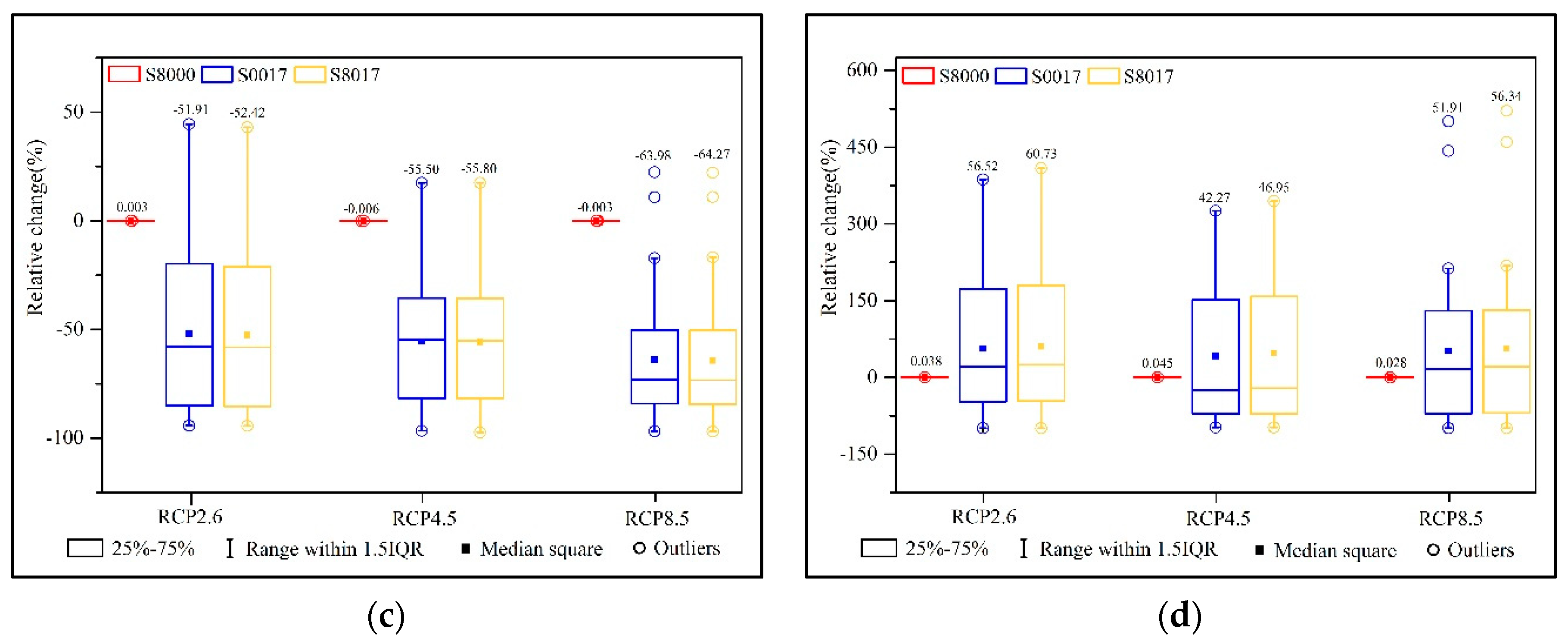
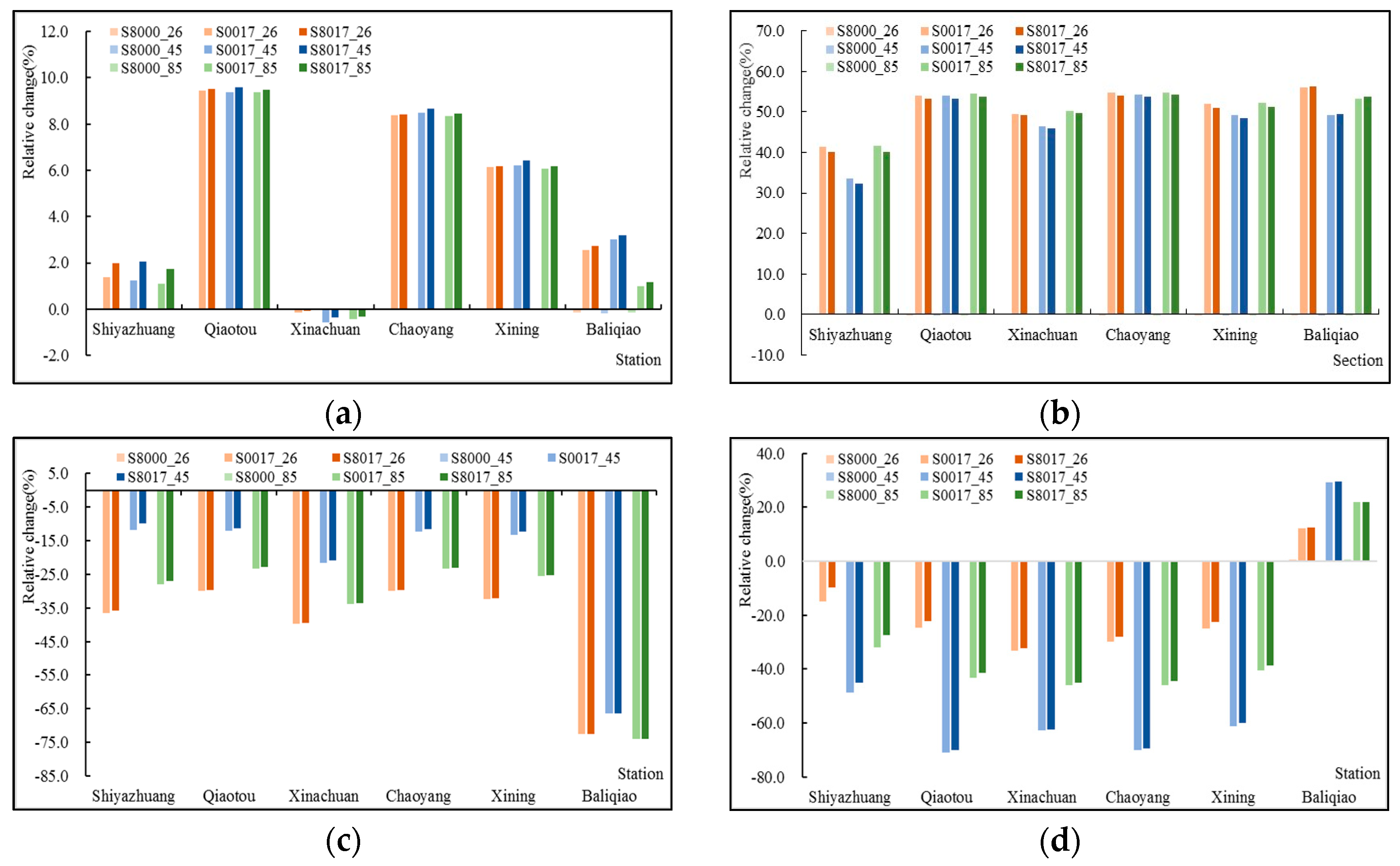

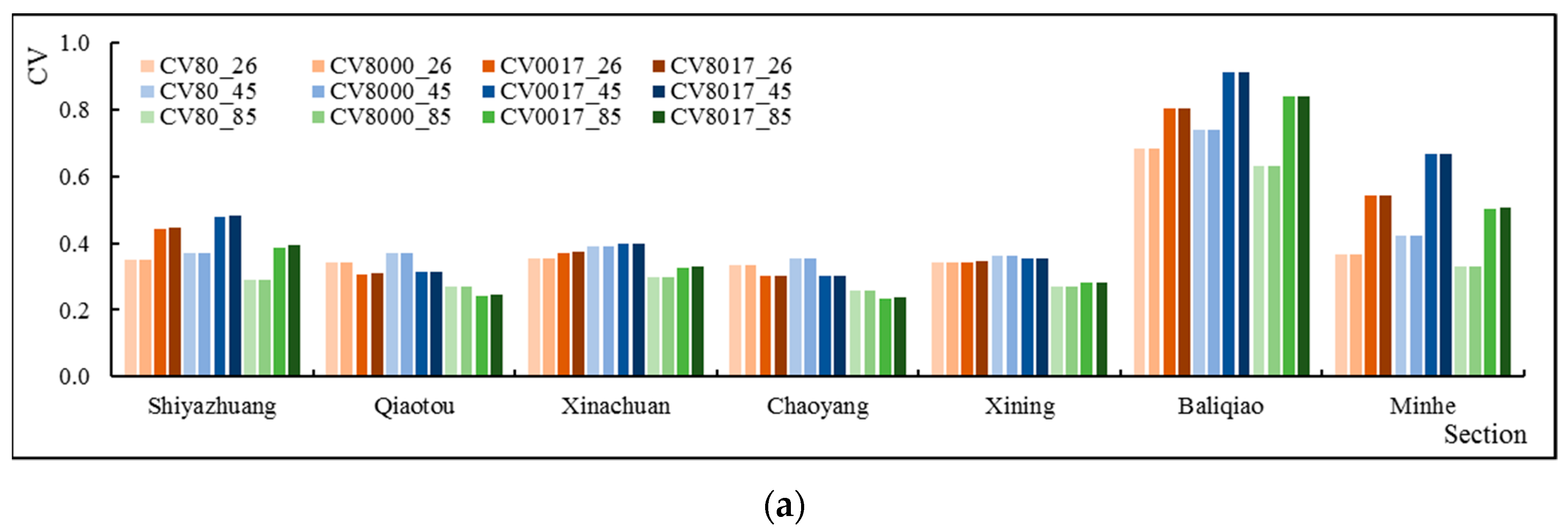
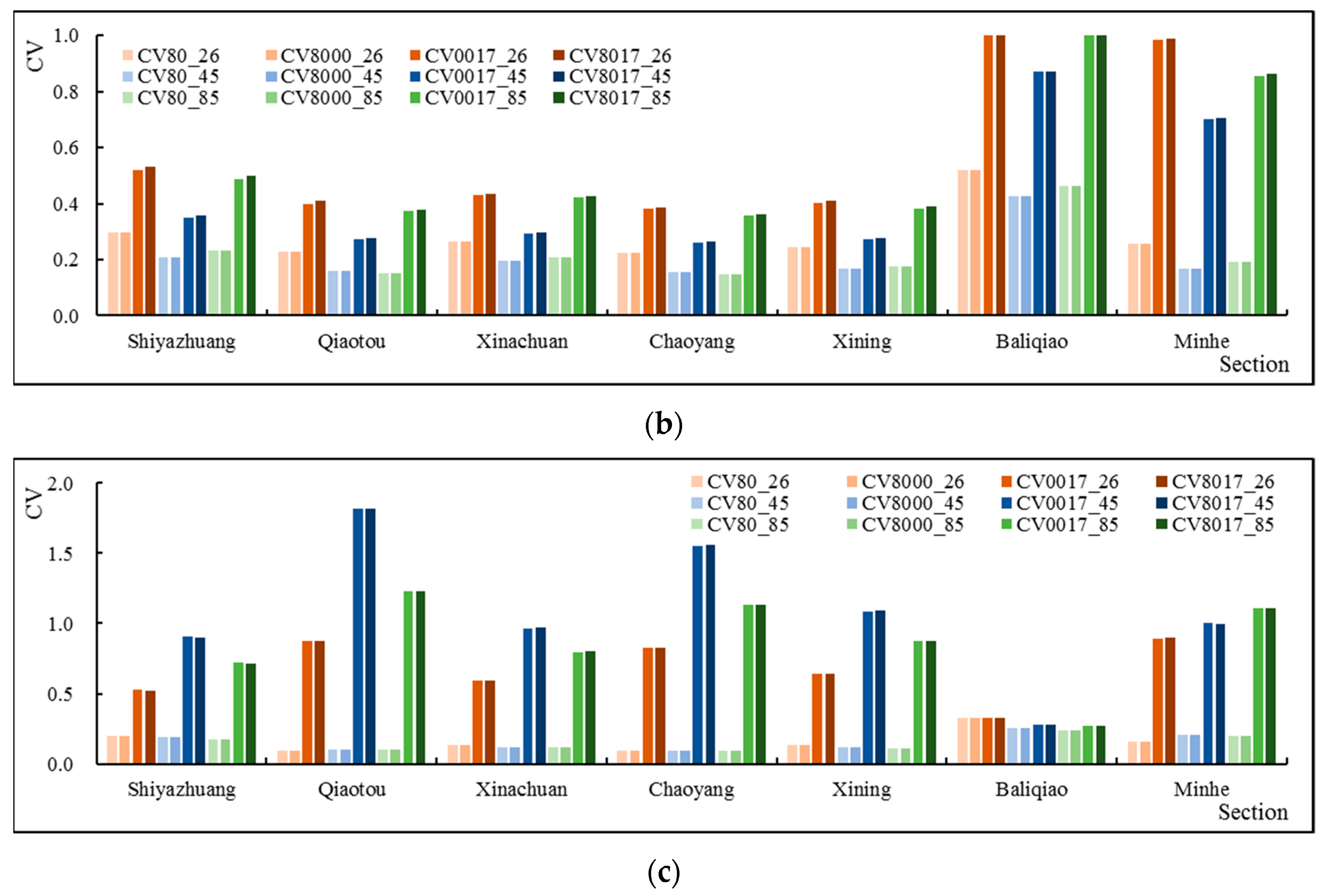
| Index | Wet Season | Temperate Season | Dry Season |
|---|---|---|---|
| Month | 6–9 | 4, 5, 10, 11 | 1, 2, 3, 12 |
| Range of runoff (m3/s) | 68.15–104.34 | 54.15–104.89 | 24.67–32.52 |
| Percentage of the year | 47.48 | 38.43 | 14.09 |
| Data Type | Data Name | Data Source | Description |
|---|---|---|---|
| Topographic data | Digital Elevation Model (DEM) | National Geomatic Centre of China | Resolution is 90 × 90 m |
| Meteorology | Surface temperature | China Meteorological Data Service Center | Select daily data of the 6 meteorological stations (1960–2017) |
| Relative humidity | |||
| Wind speed | |||
| Precipitation | |||
| Sunshine duration | |||
| Soil | Types and Physical properties | China Soil Data Survey, China Soil Database | Reclassification according to soil category of soil database in China |
| Administrative division | City, county and village distribution | National Geomatic Centre of China | defined and published by the State Council of the People’s Republic of China and provincial government |
| Landuse | Landuse types | National Geomatic Centre of China and Department of Nature Sources of Qinghai Province, China | Landuse in 1980, 2000 and 2017 |
| Hydrology | Location of hydrological station and reservoirs, runoff volume | Water Resources Department of Qinghai Province, China | Monthly runoff volume of the four hydrological stations (1965–2017) |
| Future climate scenarios | Precipitation, average temperature, average relative humidity, wind speed, solar radiation | Intergovernmental Panel on Climate Change (IPCC); Inter-Sectoral Impact Model Inter-comparison Project (ISI-MIP) | Daily data from 2021–50 |
| Modeling Center | Country | Model |
|---|---|---|
| Geophysical Fluid Dynamics Laboratory (GFDL) | United States | GFDL-ESM2M |
| Hadley Centre for Climate Prediction and Research, Met Office | England | HADGEM2-ES |
| L’Institut Pierre-Simon Laplace (IPSL) | France | IPSL-CM5A-LR |
| Technology, Atmosphere and Ocean Research Institute, and National Institute for Environmental Studies | Japan | MIROC-ESM-CHEM |
| Norwegian Climate Centre | Norway | NORESM1-M |
| Index | GFDL-ESM2M | HADGEM2-ES | IPSL-CM5A-LR | MIROC-ESM-CHEM | NORESM1-M |
|---|---|---|---|---|---|
| Correlation coefficient | 0.832 | 0.827 | 0.825 | 0.850 | 0.841 |
| Nash efficiency coefficient (NSE) | 0.658 | 0.652 | 0.639 | 0.697 | 0.679 |
| Relative error (%) | 3.709 | 3.535 | 3.758 | 3.156 | 3.210 |
| Index | Gathered Model |
|---|---|
| Correlation coefficient | 0.888 |
| NSE | 0.788 |
| Relative error (%) | −0.002 |
| Station Name | Parameter | Calibration Period (before 1985) | Validation Period (after 1985) |
|---|---|---|---|
| Xinachuan | NSE | 0.74 | 0.63 |
| R2 | 0.88 | 0.76 | |
| Relative error(%) | −0.70 | −7.58 | |
| Qiaotou | NSE | 0.72 | 0.72 |
| R2 | 0.85 | 0.86 | |
| Relative error(%) | −16.71 | −12.94 | |
| Xining | NSE | 0.70 | 0.64 |
| R2 | 0.84 | 0.83 | |
| Relative error(%) | −12.37 | −10.50 | |
| Minhe | NSE | 0.65 | 0.62 |
| R2 | 0.86 | 0.84 | |
| Relative error(%) | −12.23 | −15.28 |
| Abbreviation | Description |
|---|---|
| S80 | No slope ecological restoration scenario |
| S8000 | 1980–2000 slope ecological restoration scenario |
| S0017 | 2000–2017 slope ecological restoration scenario |
| S8017 | 1980–2017 slope ecological restoration scenario |
| S26, S45, S85 S8000_26, S8000_45, S8000_85 S0017_26, S0017_45, S0017_85 S8017_26, S8017_45, S8017_85 | Different climate scenarios + different periods for slope ecological restoration scenarios, e.g., S8000 represents the 1980–2000 slope ecological restoration scenario under the same climate scenario, S26 represents the RCP2.6 under the same slope ecological restoration scenarios, and S8000_26 represents the 1980–2000 slope ecological restoration scenario under RCP2.6 |
| CVS80, CVS8000, CVS0017, CVS8017 | Coefficient of variation (CV) of the slope ecological restoration scenarios in different periods |
| CV2.6, CV4.5, CV8.5 | CV of the different climate scenarios |
© 2019 by the authors. Licensee MDPI, Basel, Switzerland. This article is an open access article distributed under the terms and conditions of the Creative Commons Attribution (CC BY) license (http://creativecommons.org/licenses/by/4.0/).
Share and Cite
He, S.; Qin, T.; Liu, F.; Liu, S.; Dong, B.; Wang, J.; Nie, H. Effects of Slope Ecological Restoration on Runoff and Its Response to Climate Change. Int. J. Environ. Res. Public Health 2019, 16, 4017. https://doi.org/10.3390/ijerph16204017
He S, Qin T, Liu F, Liu S, Dong B, Wang J, Nie H. Effects of Slope Ecological Restoration on Runoff and Its Response to Climate Change. International Journal of Environmental Research and Public Health. 2019; 16(20):4017. https://doi.org/10.3390/ijerph16204017
Chicago/Turabian StyleHe, Shan, Tianling Qin, Fang Liu, Shanshan Liu, Biqiong Dong, Jianwei Wang, and Hanjiang Nie. 2019. "Effects of Slope Ecological Restoration on Runoff and Its Response to Climate Change" International Journal of Environmental Research and Public Health 16, no. 20: 4017. https://doi.org/10.3390/ijerph16204017
APA StyleHe, S., Qin, T., Liu, F., Liu, S., Dong, B., Wang, J., & Nie, H. (2019). Effects of Slope Ecological Restoration on Runoff and Its Response to Climate Change. International Journal of Environmental Research and Public Health, 16(20), 4017. https://doi.org/10.3390/ijerph16204017





